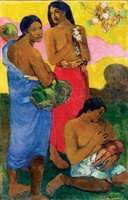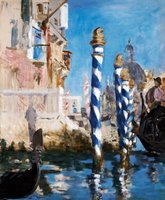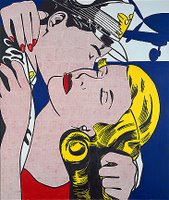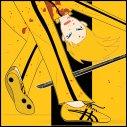For some, it is an addiction - culture, coffee... I am not one of them.
It is shows like the
Double Take at the
EMP that make me want to break on through (to the other side).
If you live in or plan to visit Seattle, and are either extremely interested in art or completed bored by it - go see this show. Here are the few reasons you should -
1) These are some of the best pictures ever created by some of the greatest master artists.
2) Some of them have never been on public display in more than 50 years*
3) You don't need to
know art** - the audio-guide is one of the best I have ever used in any museum. It gives you enough technical details on each piece, but also lets you form your own impressions.
4) Just 28 images, so you will not be overwhelmed!
5) You can walk up close to the picture/photograph and actually see the texture - yes, you can get that close.
6) There is something for everyone - Manet to de Kooning.
7) At $8, its less than a movie to go see it!
The exhibition lets you plunge into a pool of great works, with no historic anchors or cultural shackles - so you are free at last to look at these paintings as they were meant to be. It lets you see the abstract in impressionist paintings and the realism/emotional core of post-impressionist or modern art. You finally see the great masters for who they really were - innovators, rebels, risk-takers. And discover the sea of emotions and grace that lies beneath the seemingly loud and rebellious art of the post-impressionists.
And what is even better, its not a tedious art history lesson, but something you will just experience as you walk through and see each set as it is laid out.
The curator, Paul Hayes Tucker, has neatly divided the 28 pieces into small sets. Some of the pairings are absolutely daring and bold. There are sets where the audio-guide is indispensable. But once the context has been set by the guide, you begin to have these amazing "ah-ha" moments, that are completely your own.
For instance, Gauguin and Yanobe - who would have thought?! But once you are walked through the essential color, line, shape, space and texture..., you slowly begin to see the alienation and longing. Initially the Gauguin is the one that seems real, but wait, isn't the Yanobe a photograph (and hence more real)? Slowly you see facades disappear and the art appear.

Gauguin
|

Yanobe
|
Another set shows you how even great artists sit on shoulders of giants who preceeded them. Here is a perfect example, the Grand Canal in Venice. Over centuries so many renowned artists had painted it, that Monet is said to have been absolutely reclutant to go there - what could his work possibly add?
But as you can see below, his work is a culmination of sorts, of all the great artists before him - Canaletto's photographic accuracy, Turner's dream-like hazy quality, Manet's bold strokes. Now when you look at Monet's Grand Canal, you see how all these pieces contribute their own influences to his and yet, his work is just as unique.

Canaletto
|

Turner
|

Manet
|

Monet
|
And no visit to a gallery is complete, until you discover a few new artists. One of my artist-discoveries here was - Eric Fischl (below, is his -
Krefeld Project, Bedroom, #6 (Surviving the Fall Meant Using You for Handholds) (2004)).
Makes you almost lookaway, like you are going to be caught peeping through the blinds...
* They might never be displayed in public ever again - they are from Paul Allen's personal collection.
** And a very accessible introductory video featuring Dr. Neils Crane (aye, of Fraiser fame) and the curator Paul Tucker.










